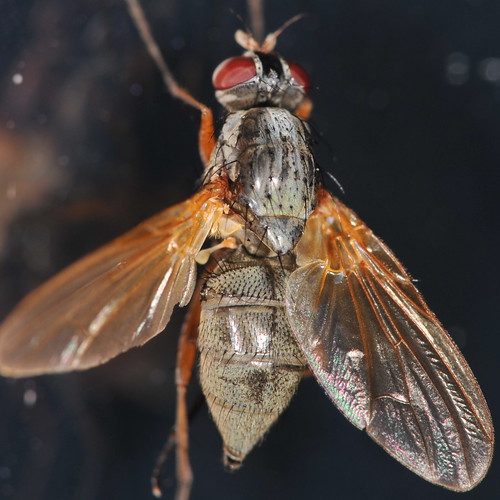Thread subject: Diptera.info :: Anthomyiidae flew inside (= Eutrichota cf. lipsia)
Posted by John Carr on 02-11-2010 18:06
#1
Last November 1, Massachusetts, USA. Insects flew late last fall. Size 10 mm. I think it is female Anthomyiidae.

More and larger pictures
http://www.flickr...11/detail/
Edited by John Carr on 28-10-2013 14:58
Posted by javanerkelens on 02-11-2010 18:27
#2
Looks like Eutrichota...
Do you have a sharp view on the arista and frontal vitta.
Joke
Posted by John Carr on 02-11-2010 19:21
#3
I don't have the arista in focus but I have several nearly in focus views that convince me it doesn't have a large plume and probably none at all.
Views of head with the back half of the front more or less in focus (from the set linked below the original picture):
http://www.flickr...8/sizes/o/
http://www.flickr...7/sizes/o/
And a top view that didn't get the top in focus:
http://www.flickr...172652211/
Is
Eutrichota formerly part of
Pegomya?
Edited by John Carr on 02-11-2010 19:22
Posted by javanerkelens on 02-11-2010 21:03
#4
Previous Eutrichota was called Pegomyza.
Eutrichota has indeed resemblance with Pegomya but differs mainly on structure of male genitals and the long/pubescent arista (in some species almost bare)
Eutrichota mostly is a very large fly and has long legs..
In this case the arista seems indeed only pubescent and it seems that the midtibia has no av seta....and with tarsomeres 3+4 distincly expanded.....
With this combination, I would say Eutrichota frigida. (90%)
Joke
Posted by John Carr on 03-08-2012 23:35
#5
I have acquired the relevant section of
Flies of the Nearctic Region. According to Griffiths
Eutrichota frigida has tarsomeres 2-4 slightly expanded. The local species with these tarsomeres twice as wide as the fifth, as in my fly, are
E. lipsia and possibly
E. tarsata, which differ in other details.
Are there any pictures or drawings available of the fore leg of female
E. frigida?
Posted by javanerkelens on 04-08-2012 14:54
#6
Unfortunally I don’t have the part about Eutrichota from Griffiths. (I will order them soom, but they are very expensive, so just save enough money to order all parts at ones)
The tarsomeres in E. frigida are longer, comparing with the tarsomeres on your photo, who seems shorter.
I can’t confirm if it is E. lipsia, but with a nice Nearctic key in hand…you could ID it on your one, without help.|t
Edited by javanerkelens on 04-08-2012 14:55
Posted by John Carr on 04-08-2012 15:07
#7
I'm also missing an important part of Griffiths -- the key to
Eutrichota. The species descriptions are in number 4 but the key must be in number 5, which I don't have. The volume breaks are not at logical divisions.
Posted by javanerkelens on 04-08-2012 18:56
#8
What a shame....when I have number 5, I will send you a copy of the key!
:)
Posted by John Carr on 28-10-2013 14:58
#9
I have Griffiths' key now, but I lack confidence interpreting the degree of dusting on the thorax. Michael Ackland has just identified a male specimen from nearby as
Eutrichota lipsia and I suspect this female is the same, common species.
Edited by John Carr on 28-10-2013 14:59
Posted by javanerkelens on 28-10-2013 20:14
#10
Nice !
Johanna
